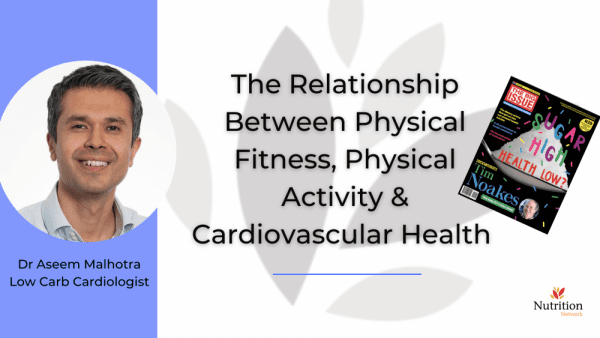
By Dr Aseem Malhotra – Low Carb Cardiologist
The relationship between physical fitness, physical activity and cardiovascular health has been a keen topic of research and political nuance since the 1960s. The late US President John F Kennedy was in fact one of the first world leaders to recognise the importance of structured exercise to individual and population physical and mental wellbeing. If his comments are as relevant today as they were in the 1960s, the policy measures he adopted were visionary and arguably superior to anything we see in the modern era.
The fact that cardiovascular disease now accounts for more global deaths per annum than any other disease begs the two step question – why is that, and what can we do to reduce the incidence and burden of CVD?
Research clearly indicates that regular physical activity is beneficial for cardiovascular health – generally speaking, the more active or fit a person, the lower their tendency will be to develop heart disease than their sedentary peers. If JFK’s “fitness for all and start in the schools” was a prolific, promising program, modern policies have failed to make any impact on the deterioration of cardiovascular health.
That our children are more overweight and unfit than at any time in human history is deeply concerning. Meanwhile almost 80% of the adult population in the UK is already overweight or obese. A highly processed food environment supported by slick advertising campaigns that deliver unhelpful and inaccurate health messaging is a critical issue here.
In 2015 I co-authored and published a paper “You cannot outrun a bad diet” to counter the incorrect belief that exercise alone will free you from any concerns about what or how much you can eat. As far back as the 1970s a young South African researcher had shattered the prevailing scientific opinion that marathon runners could not get heart disease. No surprise then that Prof Tim Noakes would go on to become the greatest endurance sports scientist of the modern era – and a co-author on the aforementioned paper.
To be clear, this is not to detract from the remarkable benefits one can enjoy through exercise and physical activity in relation to physical, mental health and wellbeing. As part of a lifestyle protocol to prevent, manage or reverse heart disease I will always prescribe physical activity for my patients whatever their sex, age or stage of disease progression.
The totality of the evidence indicates that physical activity is safe for all of us. From walking 30 minutes each day to taking the stairs instead of the escalator, every little helps. When we conducted our research in southern Italy for the Pioppi Diet, it was revealing to hear about an elderly lady in the village who cursed the steep steps she had to confront several times a day to get to and from the village. The irony of course is that those “damned steps” are undoubtedly a key factor in her impressive longevity and health span. Habitual movement can be very powerful indeed so taking the time to plan it into your average day is the cheapest and easiest “exercise” intervention you can start today.
As Prof Noakes discovered early in his career, marathon running does not prevent heart disease, and recent research indicates that too much exercise may in fact contribute to atheroclerosis or a build up of plaque in the arteries over time. The Extra Time documentary recently uncovered and examined this phenomenon amongst elite retired gaelic footballers in Ireland.
When scanned for calcification in the arteries, the fittest amongst these retired athletes (in their late 40s to early 60s) displayed significantly higher CAC/calcium scores than their peers. That none of the players with higher CAC scores displayed any symptoms of heart disease in their standard checkup (cholesterol levels, fasting blood glucose, treadmill stress test) was particularly interesting.
While the superfit former captain of the County Down team, Paddy O’Rourke successfully “reversed” his calcification using a dietary intervention (with vitamin supplementation) to stabilise his blood glucose response to certain foods, the player with the highest CAC score who ran 5 times weekly subsequently suffered a non fatal heart attack several months after filming.
The takeaway point is that lean, fit healthy people may develop heart disease as they age if a reliance on exercise alone results in fitness levels that “trick” the individual and their doctor into thinking all is well. The heart “engine” can be robust but the soft tissue of the arteries is where the damage may go undetected, so let’s not forget that 40% of lean people develop the same metabolic illnesses as overweight and obese individuals.
In conclusion, if you want to reduce your risk for cardiovascular disease, I would say to you that your level of habitual physical activity – through programmed exercise or your day to day lifestyle activities – is a very important consideration and one which we all have the ability to improve safely, easily and free of charge. Just bear in mind that should you wish to take the bull by the horns and set out to optimise your cardiovascular health then physical activity will not do that in isolation. A focus on diet, sleep and stress management will bolster any physical activity or exercise program to really set you on the path towards optimal metabolic and heart health.
The information in this article was published in The Big Issue Magazine (Jan-Feb 21 edition)
If you think you suffer from any medical condition, you should seek medical attention immediately. Please do not delay seeking medical advice, disregard medical advice or discontinue medical treatment because of information in this article.
For the latest training in LCHF/Keto Nutrition, join the Nutrition Network here.
